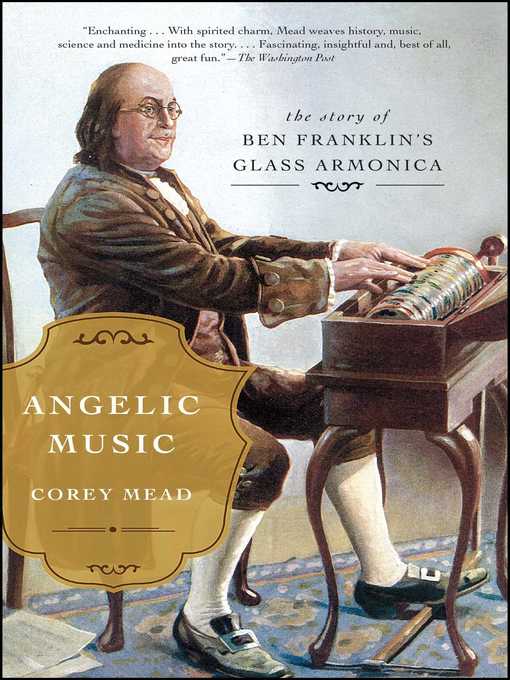
Angelic Music
The Story of Benjamin Franklin's Glass Armonica
- اطلاعات
- نقد و بررسی
- دیدگاه کاربران
نقد و بررسی

June 20, 2016
In this charming and fascinating book, part musicology and part cultural history, Mead (War Play) looks at how Benjamin Franklin developed his most cherished invention, the armonica—a mechanized instrument based on “musical glasses” and consisting of glasses of various sizes arranged on a spindle that could be turned by a foot pedal, allowing the musician to play it with both hands, much like a harpsichord. Franklin’s armonica produced such a heavenly sound that he and others believed it had healing powers. The instrument gained enormous popularity in the 18th century in America and Europe. Marianne Kirchgessner proved such a virtuoso on the armonica that Mozart wrote two pieces for the instrument for her; novels by George Sand and E.T.A. Hoffmann feature the instrument and its effects on listeners; Franz Mesmer, the father of hypnotism, used it as part of his séances because he believed its music promoted the animal magnetism necessary for healing. By the 19th century, as Mead wonderfully explains, detractors blamed the armonica and its haunting sounds for illness, insanity, and even death, and the instrument fell into obscurity until 1960, when the German glassblower Gerhard Finkenbeiner encountered the armonica in a museum. Mead’s lively storytelling opens a window into a (as it were) mesmerizing chapter of music history. Agent: Melanie Jackson, Melanie Jackson Agency. (Oct.

The genesis, rise, fall, and rise again of Benjamin Franklin's mid-18th-century rub-the-glasses device, whose enormous popularity led to wild claims about both its salutary and detrimental effects on listeners.Mead (English/Baruch Coll.; War Play: Video Games and the Future of Armed Conflict, 2013) returns with a highly readable and informative account of the research and tinkering by Franklin, whose refinements for the playing of musical glasses (a technique known long before) resulted in an instrument whose popularity soared in his day. Mead leads us through the history of music via glass-rubbing, the history of glass itself, and then, about a quarter of the way through his text, the story of Franklin, his fascination with the sound, and his determined efforts to create a more practical instrument, the armonica. He became fairly adept with the resulting device and with it, frequently entertained his guests. Mead introduces us to the early virtuosos on the device (principally women), and from the very beginning, it seemed to have what the author calls "magical effects." Enter Franz Anton Mesmer--yes, the "mesmerism" guy--who employed it in his seances, propelling him to an enormous popularity of his own. Soon after, as Mead demonstrates, claims about a dark side of the sound overwhelmed Mesmer (as did Franklin's research showing there is no magnetic fluid in us), and the instrument virtually disappeared. The author also shows us how and why it has returned--he owns one himself--tells us about the U.S. facility that produces them (they start at more than $7,000), and interviews today's acknowledged master of the instrument, Dennis James. Despite a couple of odd errors in the text--we were not yet the "United States" in late 1762--the author is a genial historical guide. Mead keeps the current swift, removing rough rocks that might disrupt our pleasant, engaging trip downstream with him. COPYRIGHT(1) Kirkus Reviews, ALL RIGHTS RESERVED.

September 1, 2016
Mead (War Play) examines the history of the glass armonica, a musical instrument invented by Benjamin Franklin, which consists of a series of glasses on an iron spindle (rotated by a foot pedal) mounted in a flat wooden case and is played by the fingers slightly touching the rotating glasses. The resulting ethereal tones fascinated listeners in the late 18th and early 19th centuries, and major composers, including Wolfgang Amadeus Mozart, wrote music for the instrument. Mead traces the antecedents of the glass armonica, highlights some of its finest exponents, and describes its eventual neglect and recent reemergence as a viable instrument. An interesting chapter chronicles its supposed "ill making" properties as well as its use by hypnotherapy pioneer Franz Mesmer, himself a fine player. The book covers some of the same ground as William Zeitler's The Glass Armonica; for scholars, Zeitler's 25-page bibliography is invaluable. VERDICT A solid choice for readers interested in the history of music (especially musical instruments or the physiological/psychological/social effects of music) and/or the life and times of Franklin.--Bruce R. Schueneman, Texas A&M Univ. Lib., Kingsville
Copyright 2016 Library Journal, LLC Used with permission.




دیدگاه کاربران